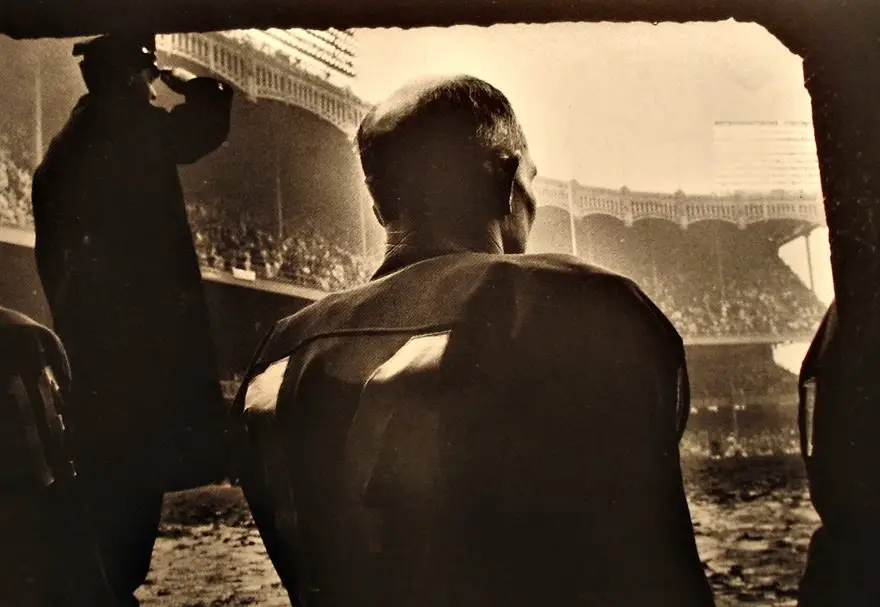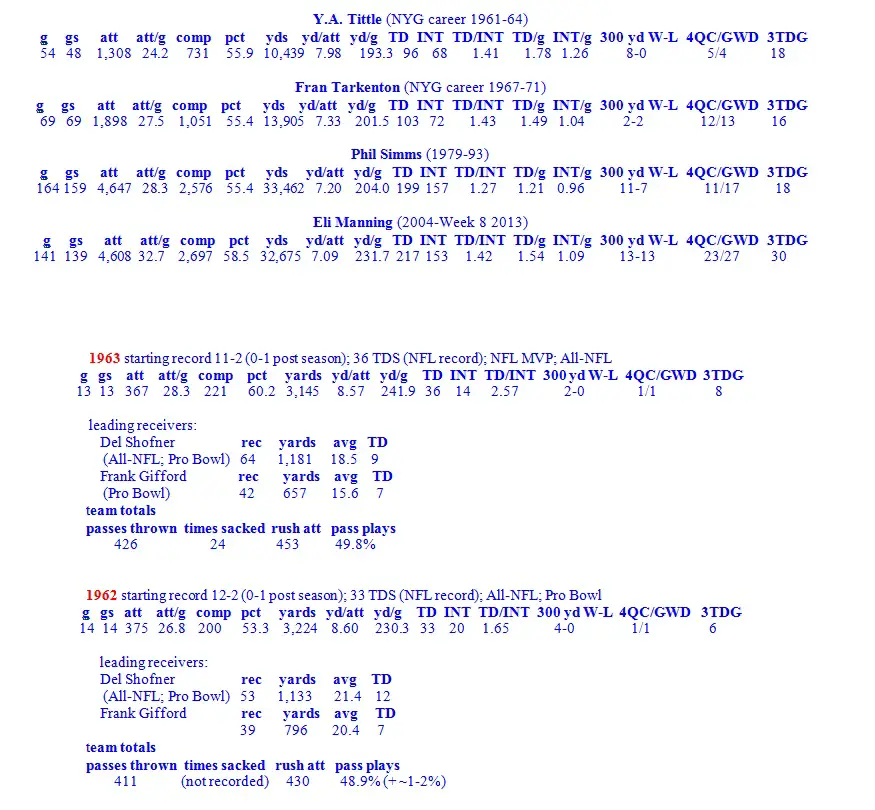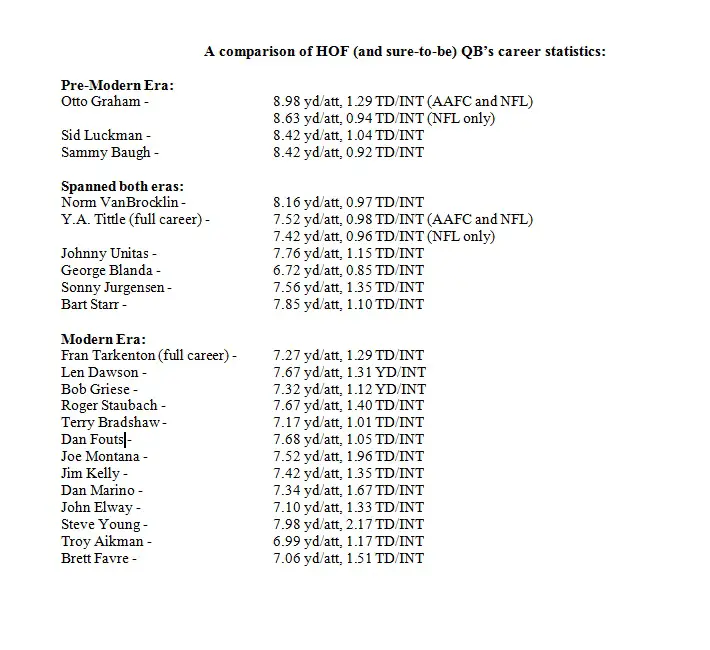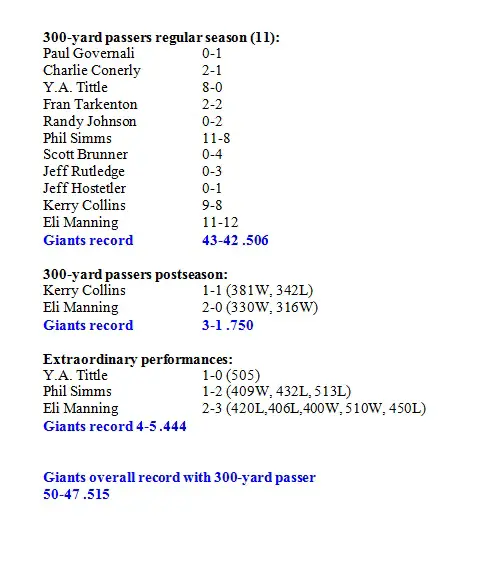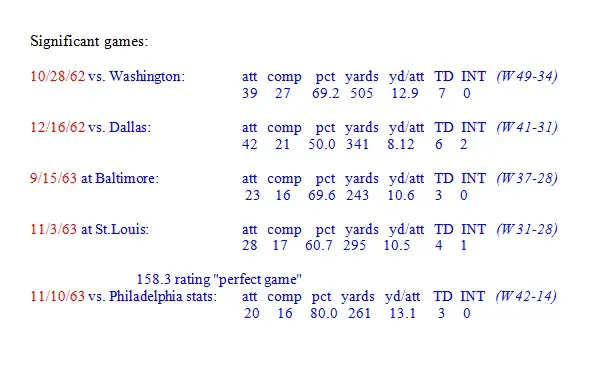Y.A. Tittle’s Incomparable 1962 and 1963 Seasons
The potential of a tree exists inside every seed. Unbeknownst to all, the seed of the Giants offensive explosion of the early 1960’s was planted in 1948 and began to take root simultaneously on opposite coasts during the 1950’s.
Frustrated by the Giants’ inability to adequately replace retired Mel Hein at center, Head Coach Steve Owen reluctantly conceded to integrate the burgeoning T-Formation into New York’s playbook. The Giants had almost exclusively run the A-Formation for over 15 years, which was Owen’s brain child. Deception and accuracy of the center snap was the key to its success, as the uncertainty of which member of the backfield would receive the ball kept defenses tentative. The T-Formation eliminated that problem as the quarterback received the snap directly from the center.
Owen had a great mind for defensive strategy. He strongly believed in power football and winning on the line of scrimmage, but struggled greatly to keep up with current trends in offensive football. Having recently invested in a quarterback via a trade with Washington, Owen created a position on his staff devoted exclusively for the purpose of tutoring Charley Conerly on the finer points of quarterbacking.
Specialist Allie Sherman received inspiration directly from the source. As a teenager he had read the Rosetta Stone on the subject: “The Modern T- Formation with Man-in-Motion” by Clark Shaughnessy, George Halas and Ralph Jones, and was eager to pass along that knowledge. Conerly had a magnificent rookie season under Sherman’s tutelage, setting a record with 22 touchdown passes for a rookie, which stood for 50 years until it was broken by Peyton Manning in 1998.
Owen, however, was impatient with the T-Formation and never fully committed to it. The Giants frequently reverted to the familiar and comfortable A-formation. After two seasons of decline in 1952 and ’53, Giants management made the difficult decision to relieve Owen of his position. The major impetus behind the move was Paul Brown’s juggernaut from Cleveland that had merged into the NFL from the AAFC in 1950. The Browns dominated the NFL’s American/Eastern Conference with creative offensive concepts that featured passing as a primary weapon. After being passed up for the head coach position for Jim Lee Howell, Sherman left New York and took a coordinator’s position in the CFL.
Vince Lombardi joined Howell’s staff as the offensive coordinator and brought Army Black Knights Earl “Red” Blaik’s T-Formation playbook with him. It was primarily a run-heavy offense, but still versatile. Lombardi added a wrinkle that used Single Wing blocking schemes for the offensive line. The pulling guards led the way for the multi-talented halfback Frank Gifford, and brought the Giants back on equal footing with Cleveland. The two teams clashed for conference supremacy for the next 10 seasons.
Sherman returned to the Giants in 1957 as a scout. When Lombardi departed for Green Bay following the 1958 campaign, Sherman took over the vacated offensive coordinator position. The results were immediate and profound. Conerly, at age 38 and in his 12th season, experienced a renaissance. He led the league in yards-per-attempt while throwing just four interceptions, and the Giants catapulted from 10th in points scored in 1958 to 2nd in 1959. Conerly enjoyed his finest season since his rookie year and was named the NFL’s Most Valuable Player.
Integration
Howell retired after the 1960 season and Sherman finally received the head coach position he had coveted. Conerly was two years older now and the wear of 14 years in the NFL was becoming evident. In moves that surprised many, the Giants traded for two veteran players deemed past their prime by their respective Western Conference clubs.
The first move was getting a quarterback who was not much younger than Conerly himself: Y.A. Tittle. The 34-year old passer had begun his career in professional football with the AAFC Baltimore Colts in 1948. When the franchise folded after the 1950 season, Tittle went to San Francisco where he was a member of the 49’ers famed “Million Dollar Backfield” with Hugh McElhenny, Joe Perry and John Henry Johnson. Tittle’s signature play was the “Alley Oop” pass to receiver R.C. Owens, would run a deep route and attempt to out-leap the defender for the ball. However, new coach Red Hickey installed the shotgun offense in 1961, which was better suited for the younger and more mobile John Brodie.
Despite his age, Tittle still had a very strong arm and was an exceptionally accurate passer. His quick release was regarded as second only to that of Johnny Unitas. Tittle also was a resourceful diagnostician of defenses; he called brilliant games and possessed rare leadership skills. “Here was a 34-year-old quarterback,” Giants president Wellington Mara said. “But we knew he would be a top hand for us. He’s been in the league a long time and he knows defenses and he would fit in with our club real well.”
Next was a trade for a receiver fast enough to get down the field vertically in Del Shofner. Once timed at 9.8 in the 100, Shofner stretched the field like few other receivers from the split end position. Mara said the veteran receiver “fitted a need of ours precisely.”
On-field colleagues agreed with that assessment. Giants veteran receiver Kyle Rote said, “Other receivers may have better moves, but Del has great speed, wonderful hands and good leg drive.” Defender Dick Lynch said, “I couldn’t cover him man on man in 1958 or 1959. I couldn’t cover him in 1960 either. He’s as good as he ever was.”
Tittle was equally impressed, “We both came here at the same time, and we both were traded from West Coast teams. I’d never thrown to someone with the speed he had – along with such a good pair of hands.”
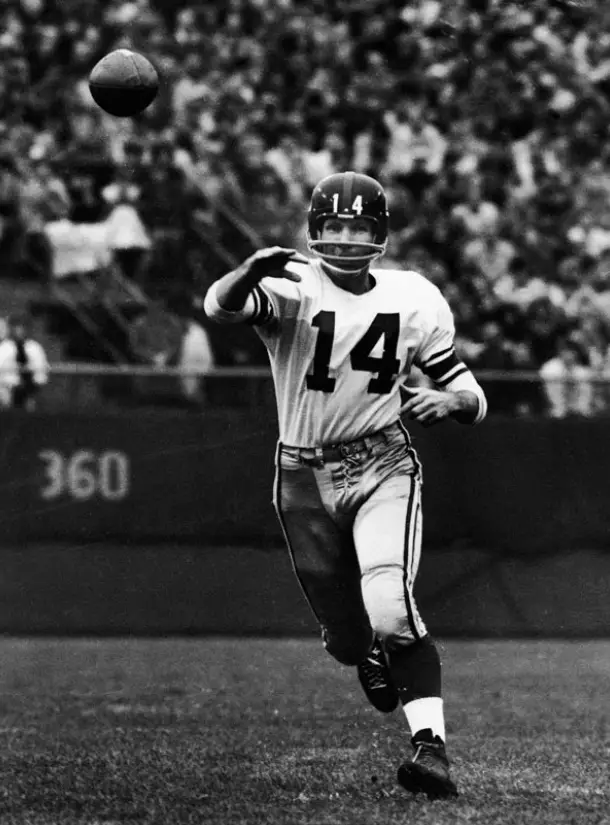
Y.A. Tittle, New York Giants (1961)
Tittle and Conerly began 1961 sharing the signal calling duties. The trend was for Conerly to start, then be relieved at some point by Tittle, who was still learning the nuances of Sherman’s complex, detailed system. Following a string of come-from-behind victories the starting job was assumed full time by Tittle. Fullback Alex Webster remembered, “Conerly was our leader. Then, when Tittle came in, we’d never seen anything like him before.” New York won the Eastern Conference, but lost badly in the Championship Game at Green Bay 37-0.
Fruition
Prior to the 1962 season, prognosticators predicted a fall off for the Giants. Sherman recalled a meeting with the press during the pre season, “Some said, ‘It’s a shame, Allie. You’re taking over a club that’s beginning to fall apart from old age.’ The Giants were supposed to be growing old. I could evaluate the performance of the old players over a stretch of three years. I could see how much they had slipped, if they had slipped at all. I could decide which old players to keep and which old players had to be replaced. You can’t replace players wholesale, you know. You have to do it gradually.”
There was turnover on the New York roster though. Conerly and Rote retired. However, one veteran returned from a season-long hiatus. Frank Gifford moved to the flanker position and complimented Shofner’s talents perfectly. The former halfback lacked Shofner’s speed, but he made up for it with elusiveness, deception and sharp route running. Gifford clicked with his new quarterback and complimented both his smarts and ability. “Y.A. is like a high school kid with a Univac brain and a great passing arm,” said Gifford. Shofner and Gifford would exceed 20 yards per catch in 1962.
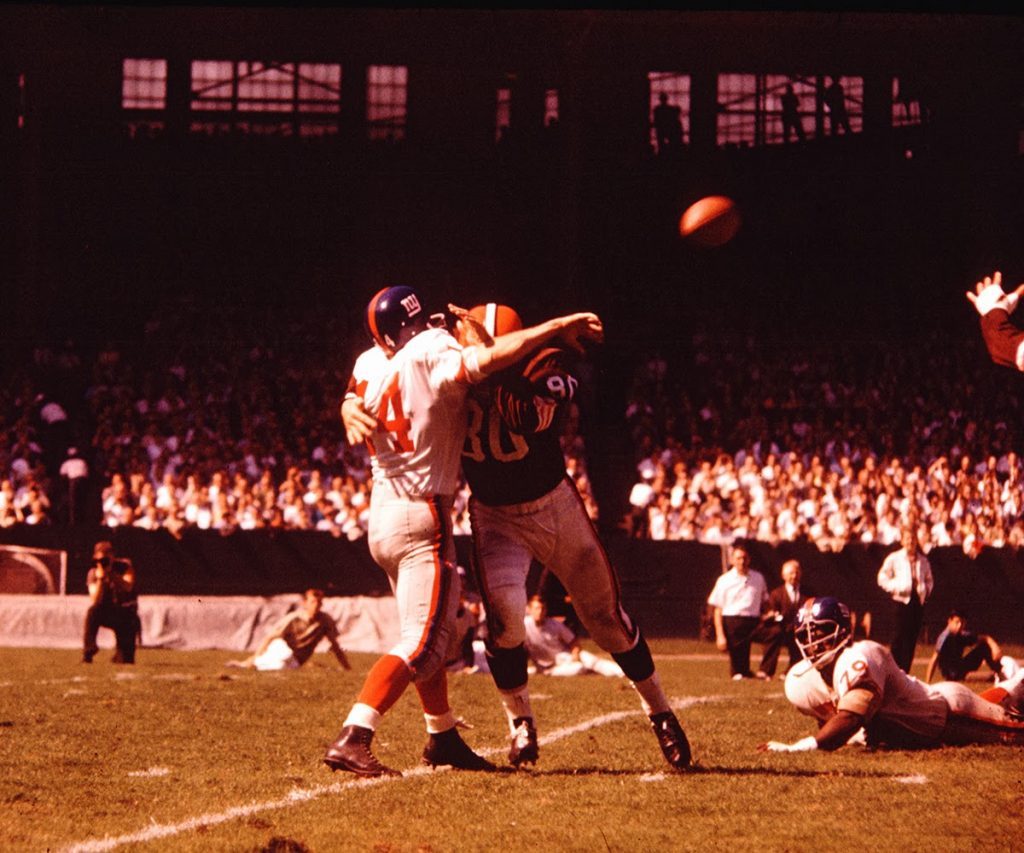
Y.A. Tittle (14), New York Giants at Cleveland Browns (September 16, 1962)
The first game of the campaign was a disappointment. A limping Tittle tossed three interceptions in an ugly 17-7 loss at rival Cleveland. Potential morphed into results for Sherman’s creative, and sometimes ingenious, offense in Week 2’s impressive passing duel between Tittle and Philadelphia’s young hot shot quarterback Sonny Jurgensen. Although Jurgensen finished with the impressive stats: 33-of-57 for 381 yards, the Giants won 29-13 with Shofner hauling in two long touchdown bombs. The following week, Tittle threw for 332 yards and four scoring strikes at Pittsburgh in a 31-27 win.
“[The game] has changed a lot since I came up in 1948,” said Tittle as he reflected on his late career success. “It’s changed a lot since 1953. You spend 10 times as much time on preparation. You go over defenses and reactions and keys and how you read. You learn little things about the other team, or about certain players you didn’t even consider 10 years ago.”
This was the first season the Giants sold out every home game before the season started. The largest crowd to date showed up for the highly anticipated contest with the 4-1 Detroit Lions. The aerial fireworks may have been at a minimum versus the defensive power from the Western Conference, but the game was thrilling nonetheless. Tittle sat our much of first half, after being shaken up on a 1st quarter touchdown run. He returned to the field in second half, and led the Giants to a 17-14 victory. His gritty performance sparked a 9-game win streak.
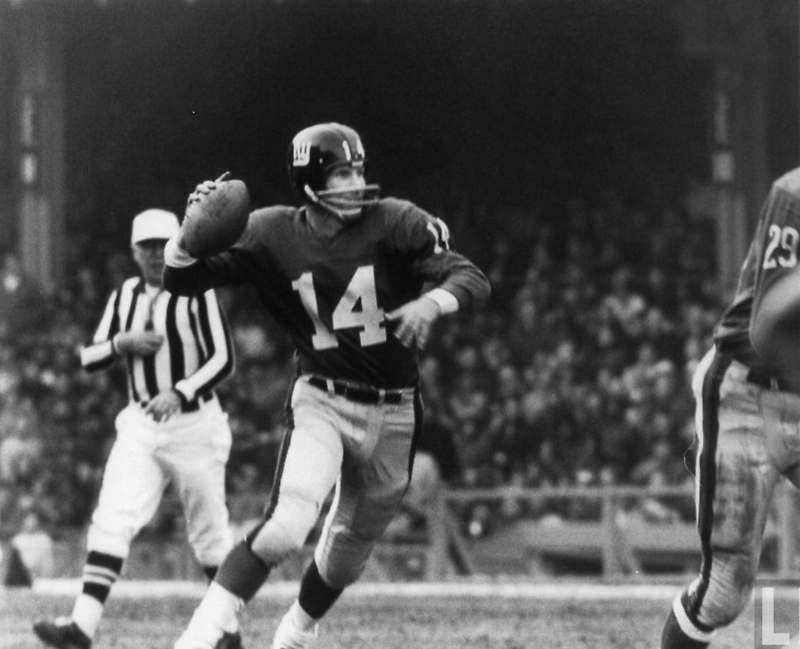
Y.A. Tittle, New York Giants (1962)
Tittle struggled during practice that week, and was a game time decision to dress against the Eastern Conference leading 4-0-2 Redskins. After convincing Sherman he was fit to play, Tittle started poorly, completing only two of his first eight attempts. The Giants trailed 7-0 and faced a third-and-ten on their own 10-yard line when their fortunes turned. Tittle completed a short pass to Gifford for the first down, and a roughing the passer penalty on the defense was added on. Tittle hit on four consecutive attempts afterward, the final being a 22-yard touchdown to Joe Morrison. Tittle led the Giants on two more scoring drives before halftime, and the Giants took a 21-13 lead. Tittle’s already had 236 yards passing and three touchdown passes despite the cold start.
Washington kept the pressure on New York with a quick strike. The first play from scrimmage of the third quarter was an 80-yard Norm Snead-to-Bobby Mitchell touchdown completion, where Mitchell caught the ball, juked his defender and outraced the Giants secondary to the end zone. Tittle answered with a seven-play scoring drive, going five-for-five passing. The Giants led 28-20 and Tittle couldn’t miss. He reached 12 consecutive completions as the Giants lead extended to 35-20. On the next possession Tittle missed on a pass and failed to match Fran Tarkenton’s record of 13 straight. Unfazed, Tittle’s next throw was good for a 63-yard touchdown to Gifford. The Giants lead 42-20 and that lead grew to 49-20 in the fourth quarter on Tittle’s record-tying seventh touchdown pass.
Tittle had a chance to try for an eighth touchdown late in the game. Despite the vocal encouragement from both the Yankee Stadium crowd and Giants teammates, Tittle called for rushing plays to run out the clock in Washington territory, content with the 49-34 victory.
The humble closing belied the superlative virtuoso performance. Tittle completed 27-of-39 attempts, nearly 70%, impressive for any game, but even more so when his bad start is taken into account. The seven touchdowns tied the record shared by Sid Luckman, Adrian Burke, and George Blanda. The 505 passing yards were second only to Norm van Brocklin’s 554, and was just the third 500-yard passing game to-date. Shofner’s 269 receiving yards was the fourth highest single-game total at that time, and remains a Giants’ club record today.
Tittle and the Giants maintained the momentum from that afternoon through most of the season and established new standards across all passing categories as they won the Eastern Conference with a 12-2 record. In the season finale versus Dallas, Tittle threw six touchdowns and established an NFL record with 33 scoring strikes for the season. Unitas had thrown 32 in 1959 and Jurgensen tied that mark in 1961. (George Blanda threw 36 in 1961, but the NFL did not recognize AFL records until after the 1970 merger.)
His 3,224 yards easily eclipsed his team record 2,272 from 1961 and Conerly’s career high of 2,175 in 1948. This mark would stand until 1984 when Phil Simms threw for 4,044 yards in a 16-game season. UPI voted Tittle and the NFL’s Most Valuable Player for the season, but the Giants lost the NFL championship game to Green Bay 16-7.
Acclamation
The 1963 season began with Tittle out-dueling Unitas in a come-from-behind thriller in Baltimore. After falling behind 21-3 early in the second quarter, Tittle threw three touchdowns to bring the Giants to within 28-24 at the half. On his third quarter touchdown run to give the Giants the lead at 31-28, Tittle was injured and left the game. Ralph Guglielmi was 0-2 in relief, but the Giants held on for a 37-28 win. The Giants were no match for the Steelers the next week without Tittle and lost 31-0, managing a meager seven first downs.
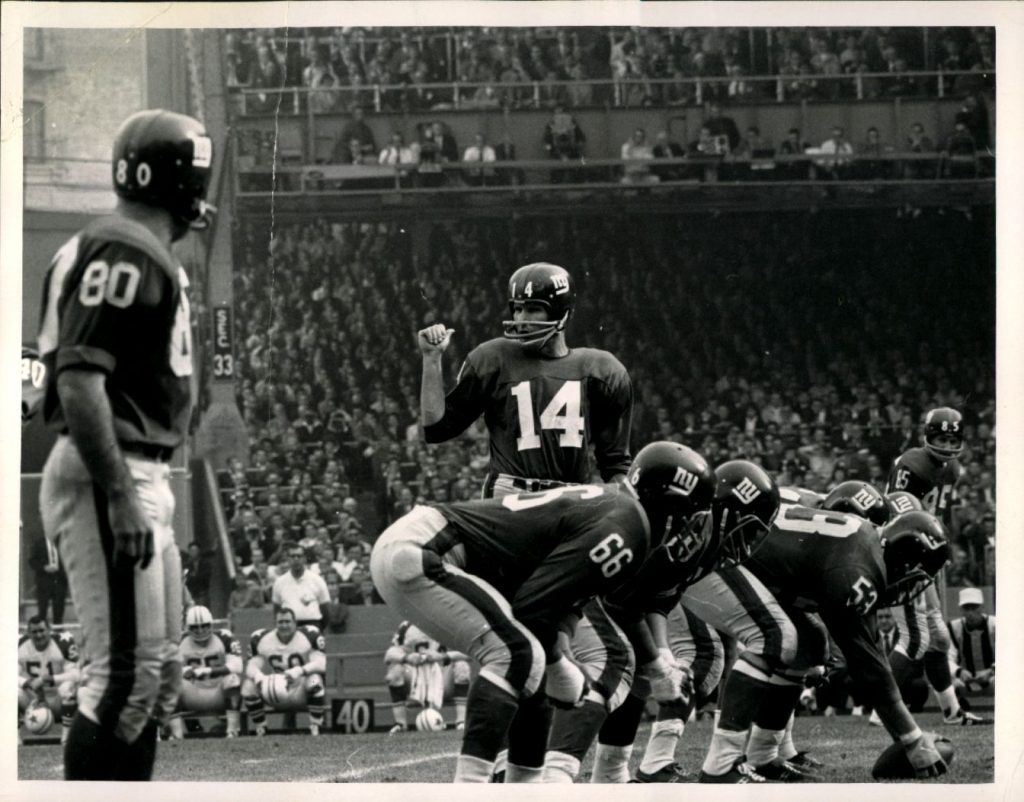
Y.A. Tittle (14), Dallas Cowboys at New York Giants (October 20, 1963)
Tittle returned in Week 3 and the offense did not miss a beat. The Giants went 3-1 after that loss, losing at home to unbeaten Cleveland, and never scored less than 24 points. The rematch with the 6-0 Browns was highly anticipated, but the standing room only crowd of 84,213 at Cleveland Municipal Stadium was silenced early when Jim Brown fumbled on his first carry and Sam Huff recovered for New York on Cleveland’s 30-yard line. The Giants settled for a field goal, but did not panic. In fact, the game plan was a departure from the usually vertical attack. Sherman’s reigned-in plan charged Tittle with managing the game with pre-snap reads and to win the time-of-possession battle. “We threw out the bomb,” Sherman said. “We never went for the long one. We wanted to control the ball. Short passes and running. That’s what we planned and that’s what we did. We showed how the Browns can be beaten.”
The Giants scored on all five possessions in the first half as Tittle changed the call on almost every play at the line of scrimmage. “They were in an odd line,” Tittle explained. “We expected them to be in a four-three most of the time, so I had to change off. If the crowd had been noisy, I might have had trouble. But they were pretty quiet.”
Tittle’s individual statistics were not flashy: 214 yards on 31 attempts and two touchdowns with one interception. As a team, the Giants totaled 387 yards on 78 offensive snaps; the Browns 142 yards on 38 snaps. Tittle received an ovation from his teammates on the New York bench when he was taken out of the game midway through the fourth quarter and the Giants comfortably ahead 33-0. It was well deserved because his decision making was the critical difference in the contest.
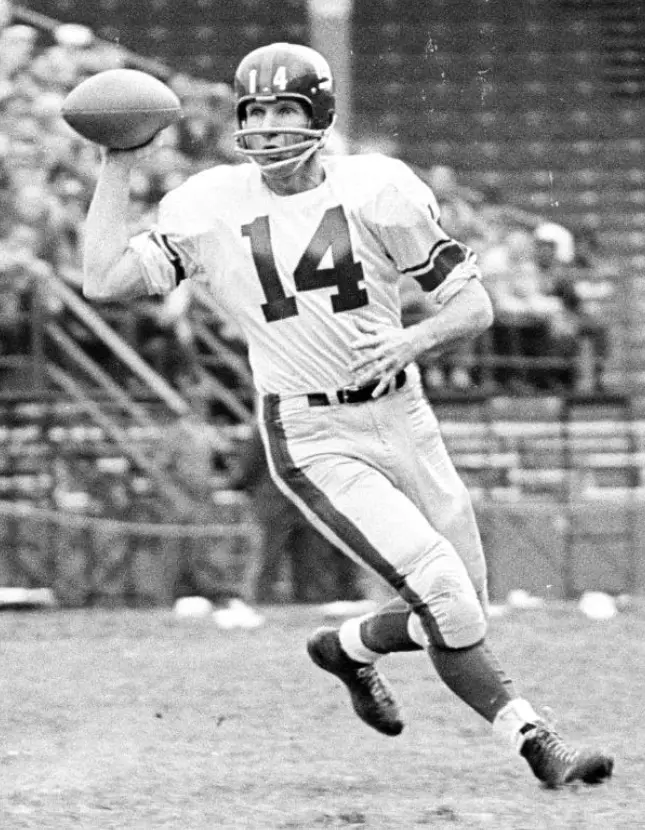
Y.A. Tittle, New York Giants at St. Louis Cardinals (November 3, 1963)
Wisdom and insight continued to serve the veteran signal caller two weeks later when he achieved a statistically perfect game for a passer in a 42-14 win over Philadelphia. Nobody knew it at the time though, the NFL’s contrived formula for passer rating was not rolled out until 1971. Although the formula has its share of critics – in particular the heavy weight it places on completion percentage – it can be a useful tool for determining a quarterback’s passing efficiency. How 16 completions on 20 attempts for 261 yards with three touchdowns and no interceptions equals the number 158.3 is not easily explained without a deep background in calculus. Tittle attributed to his success to the variable of time and intuition.
“After every game people ask me questions about how I figured the other team,” he said. “You have to be in the league a long lime and remember things, and at last you get a feel about it. If you could learn it by studying movies, a good smart college quarterback could learn all you’ve got to learn in three weeks and then come in and be as good as the old heads. But they can’t. Because you look at seven or eight different teams each year and they have a different feel and a different look.
“You learn to look for little things. Not obvious things like the linebacker coming right up on the line of scrimmage. But say my tight end is split out a little, maybe four yards from the tackle. The corner linebacker should be right out there with him, playing right in front of him so he can chuck him at the line. But if he has cheated into the gap between the end and the tackle, I read blitz. Or maybe the weak-side safety is intent on the A back—the offensive back on his side. Instead of being relaxed and at ease, he’s crouched over, and maybe unconsciously he’s moved a step or two closer to the line of scrimmage. I read blitz again. That means the weak-side linebacker is coming. He’s the man who would take the A back in a pass pattern, and the weak-side safety is going to have to cover for him, so I read blitz from the way the safety is acting.”
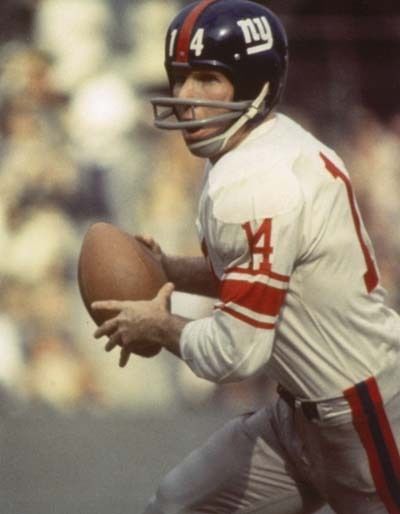
Y.A. Tittle, New York Giants (1963)
New York confidently rolled into the season finale at Yankee Stadium with a 10-3 record. Their opponent was second place 7-3-3 Pittsburgh, who could take the Eastern Conference crown with a victory via win percentage (ties did not count in the standings at that time.) A win against the rugged Steelers would require all of Tittle’s tangible attributes: a strong arm, accuracy and experience. The intangible quality of being clutch: exhibiting the uncanny ability to make a big play at a defining moment when the outcome hangs in the balance, would be the catalyst for realization.
Brains and speed combined for New York’s first big strike. Already ahead 3-0, Tittle noticed a change in the defense. After attempting a sideline hookup with Shofner, the Pittsburgh cornerback was cheating toward the boundary, after starting the game playing off Shofner to guard against the split end’s speed. Reading the defender after the snap, Tittle lured him with a pump-fake to the sideline as Shofner streaked past. Tittle lofted a deep arching throw to Shofner who coasted for the 41-yard touchdown.
Shofner left the game in the second quarter with an injury, but the Giants controlled the first half and led 16-3 at the intermission. The Steelers surged in the third quarter and cut the deficit to 16-10 while their defense stifled the Giants’ offense. Faced with a precarious situation, third-and-eight on their own 24-yard line, Tittle collaborated with Gifford to pull New York out of its rut.
Gifford separated from his defender on a deep in-cut as Tittle stood tall in the pocket under a heavy rush. The pass was low and out in front, but Gifford stretched out with one arm. As he attempted to tip the ball to himself, it stuck in his hand, and fell to the ground with it secured for a completion at Pittsburgh’s 47-yard line. “I dived for the ball and I thought, ‘Well we blew it,’” Gifford recalled. “I stuck my hand out just to make the motion of going through with it – and the damn thing stuck in my hand!” While the 63,240 fans in Yankee Stadium erupted in bedlam, Tittle picked himself off the dirt. He never saw the remarkable catch as he was knocked onto his back after the release.
Tittle immediately went back to Gifford on the next play, moving to the Steelers 22-yard line with a sideline completion. The next play was a touchdown pass to Joe Morrison off a play action fake. The Giants regained the two-score cushion 23-10 and momentum that had seemingly been lost. New York held on for the Eastern Conference title with a 33-17 victory. Afterward, there was little doubt on the game’s turning point: “That Gifford catch was the end for us,” Steelers’ Coach Buddy Parker said. “It looked then like we were beginning to pick up and they were sliding. But you could see the whole club come alive after that play.”
The Giants lost the NFL Title Game in Chicago the following week 14-10, but the 1963 season was still a great success. Tittle broke his own NFL record with 36 touchdown passes – and threw a score in all 13 games he played while doing it – a feat that earned him the AP NFL Most Valuable Player award. Including the final game of 1962 and the first of 1964, Tittle threw a touchdown pass in 15 consecutive games, a New York club record that still stands today.
Appendices: Looking over Numbers
Despite playing in New York for only four seasons, Tittle still holds a place of prominence in the Giants annals. He is 17th in games played at 54, but vaults ahead significantly in the categories of performance. He is 7th in passes completed, 6th in passing yards and 5th in touchdowns thrown. Most impressive is his yards-per-attempt of 8.0, which is highest of all Giants passers who attempted at least 250 passes.
When looking over career statistics and assessing a passer’s efficiency, the most useful are yards-per-attempt and touchdown-to-interception ratio. Subjectively, 300-yard passing games are interesting. Usually when a quarterbacks throw for over 300 yards, the win-loss record hovers around .500. Y.A. Tittle was a remarkably undefeated during his Giants’ tenure when reaching that plateau. In essence, when the Giants needed Tittle to carry the team, he delivered. Another good indicator of Tittle carrying the Giants is the number of three-touchdown passing games he had. Tittle had 18 for the Giants in 48 starts – the team record until Phil Simms equaled it, but it took him 154 starts to do so.

